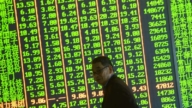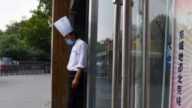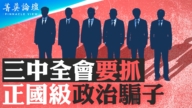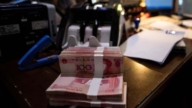【新唐人2012年12月13日訊】美國《華爾街日報》11號刊登「圖說中國的失業率和貧富差距」文章,文章指出,一份最新的調查報告,徹底打破了有關中國經濟的傳統看法。下面就來看看這份調查報告是怎麼說的:
中國西南財經大學、美國德州農工大學(Texas A&M University)教授甘犁:“在去年(2011年)8月、和今年(2012年)6月,對中國的8,000戶家庭作了兩次調查,調查表明,今年中國的經濟放緩,對勞動力市場的影響,大於人們原先所想。”
甘犁的調查發現,今年6月份,中國城鎮失業率是8.05%,僅略高於去年8月份的8%。但這差不多是國家統計局發佈的官方登記失業率4.1%的兩倍。
《六四天網》義工蒲飛:「它的4.1%是從那個登記失業人口上算的。中國沒法算,因為中國沒有一個明確的所得稅申報制度,失業(人口)應該從你每個月是否有正常收入來計算,但是你缺乏這個所得稅申報制度的話,你這個東西完全沒法算。」
而美國「南卡羅萊納大學艾肯商學院」經濟學教授謝田博士分析指出,中共當局不只失業率造假,幾乎所有數字都是假的。
美國經濟學教授謝田:「因為中共不光是失業率造假,它在GDP上也造假,在基尼指數上也造假。就是為了營造一個經濟繁榮的假象。而經濟如果要是繁榮的話,你失業率一定不能高。你失業率太高的話,你怎麼能是社會繁榮呢?怎麼能夠用來欺騙外資,吸引外資呢?所以這個數字從這個邏輯上推理,也是假的。」
報導說,甘犁所進行的失業率調查,是親自派遣做研究的學生深入城鄉,進行直接家訪,克服官方之前的障礙。
而調查報告指出,在總人口當中,大學畢業人群是失業率最低的群體,他們的失業率只有3.6%。
謝田:「如果這個社會只有4%的失業率的話,那這個大學生應該很容易找到工作。中共說它那個經濟增長是10%,失業率只有4%的話,那那個經濟增長連帶人就業,那中國肯定大學生都不夠用。」
根據甘犁的調查,中國的「基尼係數」為0.61,顯示,已超出「社會分配不公的危機臨界點」0.4甚多。另外,中國收入最高的20%的人控制著68.4%的收入,收入最低的20%的人僅控制著0.5%的收入。
他的調查還顯示,2011年有一半以上的中國家庭收入非常低,實際上沒有存下甚麼錢。相比之下,中國收入最高的10%的家庭掙錢很多,即便是在享受奢侈生活方式的同時,仍有大量的錢可以存入銀行,佔存款總額的74%。
謝田:「大家都知道失業率很高,經濟很糟糕的話,人們就會互相鼓勵,會更加…協力反抗中共政權的一個動力。它營造這種假象,讓人覺得可能其他人還不錯,只有我不好,只有我找不到工作。一貫的欺騙民眾,欺騙國際社會。」
根據《六四天網》在第一線所收集的數據,中國的農村人口有2千萬人因為「徵地拆遷」導致失業。
蒲飛:「這2千萬人的失業,肯定就會帶來一個完全的、整體的社會動盪的一個風險存在。所以,到現在為止,你要更改失業率,肯定要給別人一個能生存的制度,你這個失業率才會有所變化,如果你還是這個政策制定下去,我看不會有甚麼變化。」
甘犁說,政府的首要任務應該是收入再分配,將更多的可支配收入放到中國廣大家庭手中。而日前一份遞交中共中央和國務院的《關於社會穩定、和諧狀況調查研究》說,社會長期分配不公、貧富懸殊兩極分化,加上官場貪污腐敗、黨群關係處於緊張、官民對立情緒惡化、警民衝突頻發等,形成了社會深層次、積壓難解的不穩定因素。
採訪/李蓮 編輯/周平 後製/葛雷
Survey Reveals China’s True Unemployment Issue
On December 11th, Wall Street Journal published an article
titled,"Charting Chinese Unemployment, Inequality."
The article stated, “A new survey turns the received
wisdom about China]s economy on its head."
Let]s have a look at what more the article tells us.
Gan Li, professor at US Texas A&M University and China
Southwestern University of Finance and Economics,
carried out two surveys of 8,000 Chinese households
in August 2011 and again in June 2012.
The surveys suggest that the slowdown of China’s economy
since this year has more influence on the labor market than previously expected.
Gan’s survey finds that China’s urban unemployment rate
was 8.05% in June 2012, which is slightly higher than the 8% in August 2011.
But it is still almost twice the official unemployment rate
of 4.1% announced by the National Bureau of Statistics of the Chinese Communist Party (CCP).
Pu Fei (volunteer at 64tianwang.com): “The number of 4.1%
comes from statistics of registered unemployed population.
However, this does not work correctly because there』s
no well-regulated income tax return system in China.
The unemployment rate should include anyone
who does not have a regular monthly income.
Without an income tax return system
it is simply impossible to obtain accurate data."
Xie Tian, Professor at the Aiken Business School at
the University of South Carolina, commented on the topic.
Xie remarked that not only the employment rate is forged,
almost every officially published by the CCP number is false.
Xie Tian (Economics Professor, US):"Besides unemployment
rate, CCP also forges numbers such as GDP and Gini index.
All these are to create illusions of an economic prosperity
because if your economy is good, you should not have a high unemployment rate.
If your unemployment rate is very high, how can you
announce that you have a flourishing economy?
How can you attract more foreign investments
by deceiving them?
Even such a logical analysis can tell
that the number is probably not true."
The report mentioned that Prof. Gan’s survey was carried
out by his students who made direct home visits to urban or rural residents.
This overcomes the flaws of the official statistics.
The survey also shows, college graduates’unemployment
to be 3.6%, which is the lowest in all population groups.
Xie Tian: “If the unemployment rate is only 4% for the
whole society, then it should be fairly easy for the college students to find a job.
The CCP officially said the economic growth rate is 10%
and unemployment rate is 4%.
If those numbers are true, the economic growth will create
many more job opportunities which should lead to a shortage of college graduates."
Prof. Gan’s survey found China’s Gini coefficient to be 0.61,
which is much higher than 0.4, the critical point indicating significant social inequality.
In addition, China’s top 20% controls 68.4% of the total
national income while the lowest 20% only controls 0.5%.
Other statistics reveal that over half of Chinese families had
relatively low yearly incomes in 2011 with little savings left.
In comparison, China’s top 10% reaches families had earned
so much money that they contributed 74% of the total bank deposits, despite their luxurious life styles.
Xie Tian: “Everyone knows that a high employment rate
and bad economy will lead to more sympathy between civilians and better unity against the CCP’s regime.
Therefore, the CCP tries to create an illusion
by forging the statistics.
This can have the effect of making you feel it is your fault
that you are not able to find a job, as others are fine.
It just constantly tries to deceive the Chinese people
and the global society."
According to first-hand statistics by 64tianwang.com,
20 million of rural Chinese had lost their jobs because of land acquisitions and house demolitions.
Pu Fei: “The survival of those unemployed people will
inevitable lead to a higher risk of a wide social disorder.
Therefore, you have to provide people with ways to make
a living, if you want to make the unemployment rate drop.
If the current policies keep going like this, I"”
Gan Li remarked that the primary task of the government
should be the redistribution of the income.
That is, giving most Chinese families
more disposable income.
Instead, a recent report titled,"An Investigation on Social
Stability and Harmony" was submitted to the CCP Central Committee and State Council.
The report reveals that there have been deep-rooted,
abstruse problems leading to social instability.
And that they result from long-term unfair income
distribution, serious social inequality, and corruption,
in addition to high tension between political groups, intense
antagonism, and frequent conflicts of police and civilians.



























